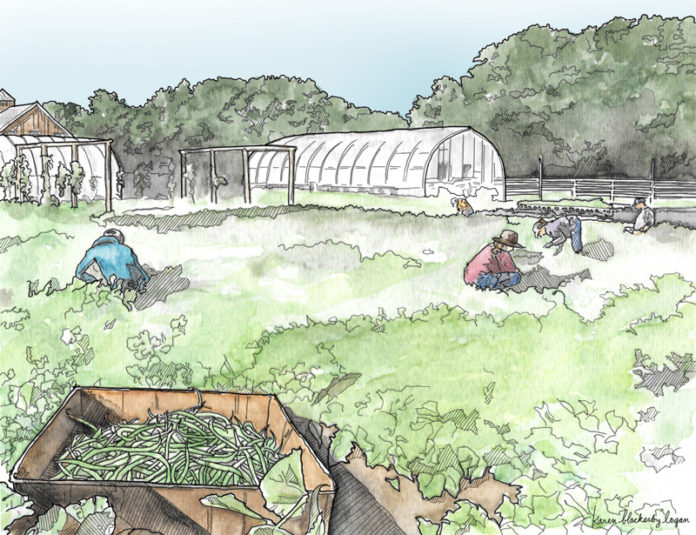When I first started growing vegetables, I felt like a complete failure. In farmstands and markets, I saw piles of smooth, straight string beans, unblemished tomatoes, carrots that didn’t twist around each other. My own garden produce was perfectly delicious, but in no way market-ready. How did those farms work such magic? As turns out, the key is overproduction. Commercial farms have to plant an excess of what they need, so they can pick the best for their customers. It leaves behind an abundance of imperfect crops in the field. Traditionally, farmers make every attempt to use the leftovers, either by donating them or using them in prepared foods, but a decade ago, Island Grown Initiative saw that they could help farmers be more productive, while increasing access to fresh, local food. The Island Grown Gleaners were born, and now, every week, all year long, a dedicated group of volunteers gathers in fields across the Island to harvest food that isn’t pretty, but still delectably and locally grown, offsetting a significant portion of that waste, and helping IGI distribute it to community members in need.
I had the opportunity to join this group of gleaners one bright weekday morning in early fall. Accustomed to “Island time” as I am, I thought I was early when I made my way to the meeting spot a few minutes before the 9 am start time. Instead, I was just in time to see the rest of the group disappear around a greenhouse, sun hats and gardening gloves in hand, eager to get started. I caught up with the crew just as Jackie Hockhanson and Marjorie Pierce, longtime volunteers and today’s glean captains, were giving tips on picking green beans, bending a few to demonstrate how we could tell which ones were too far gone to pick. There were careful instructions on which rows were to ours to pick, and where the farm was still harvesting.
For farmers like Simon Athearn of Morning Glory Farm in Edgartown, communication and organization are crucial to the success of IGI’s gleaning program. Allowing strangers onto your meticulously planned fields requires a fair amount of trust that the plants and soil will remain undamaged, and that the team will take only what has been designated for them. He says this is really where IGI shines. Simon can check his fields on Monday, leave a message for the IGI Gleaning lead, and trust that the gleaners will arrive Tuesday morning and carry out the exact plan he had in mind.
They do seem more like trained professionals than a random assortment of volunteers. There are few experiences more humbling than picking with this seasoned group of gleaners. While I was standing up to stretch and give my back a rest, feeling pretty good about my half-full box of beans, these hearty volunteers, most of them a few decades older than I, were squatting down in the rows, hard at work, exchanging their full boxes for empty ones to fill.
After an hour or so, Jackie let everyone know that we were finished with the official glean, and volunteers were given a few minutes to pick some beans for themselves, while our boxes were consolidated and brought out to the distribution van, where the culmination of the gleaning program takes place: getting this food into the bellies of Islanders in need..
On this particular day, the beans were destined for the elementary schools, where creative lunch ladies would decide how best to use them in their lunch programs. But depending on the size and type of the harvest, the time of year, and the needs of the community, gleaned produce goes everywhere from the Food Pantry and senior centers to the Wampanoag Women’s Center on a fairly consistent basis, and many others as needed. IGI also processes vegetables and prepares meals for distribution in a partnership with local chefs and Slough Cove Foundation.
According to Kayte Morris, senior director of food equity programs for Island Grown Initiative, the goal is to get the right food to the right people at the right time. It takes an intense amount of coordination and keeping up with who is growing what, and who is in need.
Luckily, they have their gleaning lead, Astrid Tilton, in charge of figuring all of that out. Astrid is passionate about food equity, and believes that everyone should be able to obtain food in a way that is convenient and feels good to them. She has spent years forming relationships not only with farmers but with Island organizations, and people feel comfortable telling her what they want and what they don’t. She’d much rather find another recipient for a delivery, or feed it to livestock at Island Grown Farm, than leave a recipient organization feeling stuck with something it can’t use.
Bolstered by the support of her gleaners and the farmers at Island Grown Farm, Astrid is continually improving the system, working on more efficient ways to harvest, and keeping up with new produce being grown on the Island. It’s an ever-changing program that works because it plays on everyone’s strengths, and what everyone has to share. Farmers are empowered to be more generous with their bounty, volunteers feel they are provided a needed service, Islanders in need get a helping hand, and all those funny-looking vegetables get the appreciation they so truly deserve.


